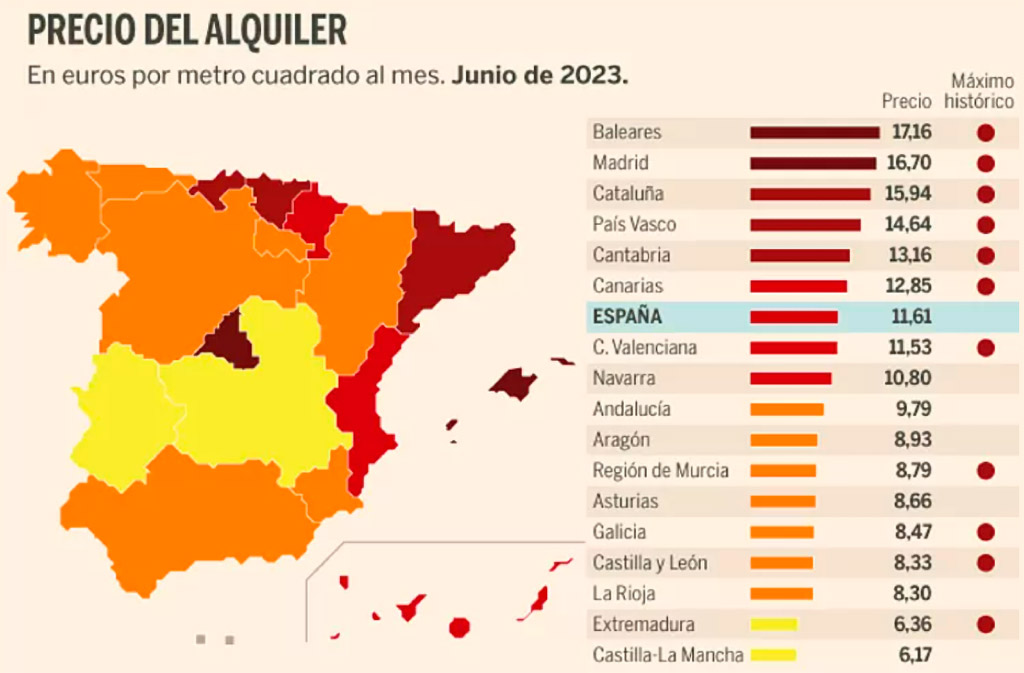Access to housing in Spain is a years-old structural problem that can be explained by several economic and social factors latent in many areas of the country, confirming the idea that the current rental market is not meeting all the demand needs. That’s why ownership has a much greater weight in the Spanish real estate market.
At Solventis we want to provide some context to the housing access situation in Spain and describe the reasons behind this problem, as well as the solutions that we as experts in the field can offer.
Context and causes of the structural crisis
The context of the structural housing access problem in Spain is divided in two main circumstances. First, there is the structural housing deficit generated by a lack of sufficient development of Spain’s rental housing market, which is even worse in areas of the country that are particularly strained
According to Spain’s Affordable Housing Observatory, the affordable social housing in the country accounted for 2.5% of the total housing stock in 2019, significantly below the EU15 European average of 15% for the same year. The website also notes that only 2.8% of rents in Spain are below market price. So the country needs to build up this type of housing stock not only to reach European standards, but also to maintain its commitment to the state’s Housing Act approved in May of 2023, which sets a target of increasing the proportion of social housing stock compared to the total number of homes by 20% in municipalities with strained areas in the next 20 years.
What are those strained areas of the country? The Big Data real estate platform Brainsre states that most of the strained areas are in Madrid, Barcelona, the Costa del Sol, the islands, and the Mediterranean coast, and include cities like Zaragoza, Valencia, Albacete, Ciudad Real, Cadiz, Huelva, and Murcia, among others. The new Housing Act considers a strained area to be any locality where the average burden of a mortgage payment or rent plus expenses is over 30% of the average income per household, or if the purchase or rental price has risen at least three points above the CPI in the five preceding years.

In terms of rental prices, according to the latest report from the website Idealista, the average monthly rental price in July of 2023 was 11.90 euros per built square meter, which means a monthly increase of 0.9%. Rental prices have gone up in 29 regional capitals, including: Barcelona, with the most expensive rent (€18.90/m2), Madrid (€17.10/m2), San Sebastian (€16.50/m2), Palma (€14/m2), Bilbao (€13.10/m2), and Malaga (€12.80/m2).
And therein lies the second factor behind the structural crisis in housing access: social vulnerability. The lack of access to affordable rental housing has a direct impact on a significant share of the population, especially families and young people.
According to Eurostat, 35% of families in Spain living in rented housing spend 40% of their income on rent, compared to the European Union average of 25%. Experts recommend that this percentage — known as the “effort rate” of purchasing or renting real estate — not go above 30%, which is to say a third of family income. The Idealista website’s study from the last quarter of 2022 lists seven capitals where the effort of renting a two-bedroom residence exceeds the recommended 30%: Barcelona requires the highest percentage of household income (39%), followed by Palma (35%), and Malaga (33%). Cities that are below the 33% include Madrid (31%), Valencia (31%), Alicante (31%), and San Sebastian (30%).
The lack of access to affordable rental housing has a direct impact on a significant share of the population, especially families and young people
Another problem is the situation among young people. The Fotocasa report “Young People and the Housing Market” from October of 2022 indicates that 52% of young people between 15 and 29 years old live in rental properties, because their economic situation prevents them from being able to purchase a home. In this sense, rental prices have a direct and absolute impact on their options for leaving home. According to Eurostat, Spanish youths leave home at 29.8 years old, three years later than the European average of 26.4 years old. Youth unemployment and the increase in rental prices in recent years are two of the clearest factors that make it difficult for young people to leave home and live independently, and therefore pursue a range of new opportunities in their lives.
In short, as indicated by Spain’s Affordable Housing Observatory, the country’s lack of affordable housing is due to several reasons, like high housing prices, constant increases in rents, the limited number of social and affordable housing units compared to the rest of Europe, and the need to spend a large portion of household income on housing. What solutions can we push forward to improve this situation among families and Spanish youth?
Possible solution: Expand the public rental housing stock
At Solventis our stated goal is to help increase the public supply of affordable social rental housing in Spain, in line with the road map set out by Public Administrations to develop 800,000 affordable social housing units in the next 10 years.
The Fondviso investment fund will respond to the needs of homes with net annual income of between 28,000 and 45,000 euros, which represent nearly 32% of the Spanish population.
It is a unique model that you can learn more about in our next blog posts, aimed at a large portion of society who until now has not had access to price-regulated housing but who suffers under the rising prices of the free market. This model will generate affordable housing throughout the country, both in the strained areas we mentioned and in other more outlying towns and cities that lack sufficient rental housing.